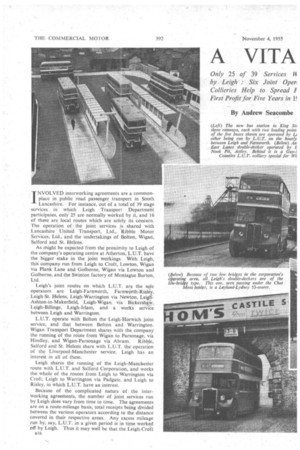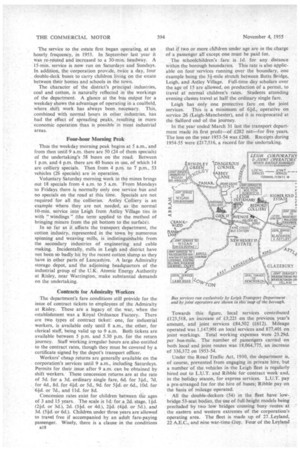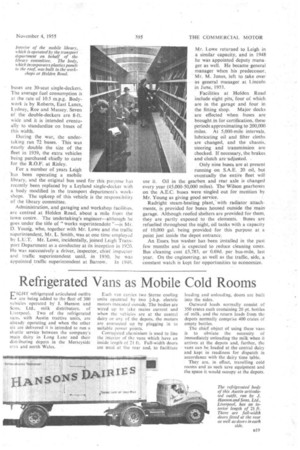A VITA OG IN A BIG WHEEL
Page 42

Page 43

Page 44

Page 45

If you've noticed an error in this article please click here to report it so we can fix it.
Only 25 of 39 Services 14 by Leigh : Six Joint Oper, Collieries Help to Spread I First Profit for Five Years in 1!
By Andrew Seacombe
INVOLVED mterworking agreements are a commonplace in public road passenger transport in South Lancashire. For instance, out of a total of 39 stage services in which Leigh Transport Department participates, only 25 are normally winked by it, and 16 of these are local routes which are solely its concern. The operation of the joint services is shared with Lancashire United. Transport, Ltd., Ribble Motor Services, Ltd., and the undertakings of Bolton, Wigan, Salford and St. Helens.
As might be expected from the proximity to Leigh of the company's operating centre at Atherton, L.U.T. have the bigger stake in the joint workings. With Leigh, this company run from Leigh to Croft, Lowton, Wigan via Plank Lane and Golborne, Wigan via Lawton and Golborne, and the Swinton factory of Montague Burton, Ltd.
Leigh's joint routes on which L.U.T. are the sole operators are Leigh-Farnworth, Farnworth-Risley, Leigh-St. Helens, Leigh-Warrington via Newton, Leigg.Ashton-in-Makerfield, Leigh-Wigan via BiekerShaW, Leigh-Billinge, Leigh-Irlam, and a works service between Leigh and Warrington.
L.U.T. operate with Bolton the Leigh-Horwich joint service, and that between Bolton and Warrington. Wigan Transport Department shares with the company the running of the route from Wigan to Parsonage, via Hindley, and Wigan-Parsonage via Abram. Ribble, Salford and St. Helens share with L.U.T. the operation of the Liverpool-Manchester service. Leigh has an interest in all of these.
Leigh shares the running of the Leigh-Manchester route with L.U.T. and Salford Corporation, and works the whole of the routes from Leigh to Warrington via Croft, Leigh to Warrington via Padgate, and Leigh to Risley, in which L.U.T. have an interest.
Because of the complicated nature of the interworking agreements, the number of joint services run by Leigh does vary from time to time. The agreements are on a route-mileage basis, total receipts being divided between the various operators according to the distance covered in their respective areas. Any excess mileage run by, say, L.U.T. in a given period_ is in time worked off. by Leigh. Thus it may well be that the Leigh-Crciit
service is worked by both L.U.T. and Leigh in one period and by Leigh only in another.
This method is singularly advantageous in these days of labour shortage. L.U.T.'s staff problem is more difficult than that of Leigh, and the corporation undertaking frequently works •off its share at times when the company's labour situation is aggravated.
Each participant in a joint service 'sends to the other operators a weekly statement detailing receipts and miles actually run, from which figures the proportion of receipts and mileage is calculated by each operator. This enables each to maintain ready 'records of the amount of excess mileage being operated at a given time or to be defrayed during the next financial year.
Services operated exclusively by Leigh run within the borough boundaries, and along one route in Hindley and one in Tyldesley. They all have their terminal points in the town centre, approximately half in Cook Street and the remainder at the new bus station in nearby King Street, one of the town's main thoroughfares. A number of the joint services also originates at these points.
Cook Street is a one-way thoroughfare off Railway. Road running parallel to King Street. The new bus station, which was first used in May this year, has displaced Railway Road as a terminal point. In its existing form, the station has been the subject of much criticism from the public.
It consists of three runways, each with an exposed 'cantilevered shelter and two loading points. Buses enter the tation, which is roughly semi-circular in design, from the north and leave at the southern end. The transport department has a small office for inspectors on the site, but there are no facilities for the public. My impressions confirmed local opinion, but in fairness to the corporation it must be stated that the station as it is today 'represents only the first stage of a long-term plan.
According to Leigh's general manager, Mr. H. Lowe, A.M.Inst.T., the station has not materially affected the operation of the bus services, although it has reduced traffic congestion in Railway Road. Financially, the transport department will suffer through the imposition of departure charges.
Few new services have been introduced in recent years. Indeed, during the past financial year there was an intensive examination of existing services resulting in the discontinuance of some and a reduction in frequency on others. One exception is the service to Higher Fold, which lies a little more than two miles from the town centre. Here a large housing estate is being built. At the time of my visit there were 424 houses and fiats tenanted, but the estate will eventually have accommodation for 2,000 families, and amenities will include churches, shops and public houses.
The service to the estate first began operating, at an hourly frequency, in 1953. In September last year it was re-routed and increased to a 30-min. headway. A 15-mM. service is now run on Saturdays and Sundays. In addition, the corporation provide, twice a day, four double-deck buses to carry children living on the estate between their homes and schools in the town.
The character of the district's principal .industries, coal and cotton, is naturally reflected in the workings of the department. A glance at the bus output for a weekday shows the advantage of operating in a coalfield, where shift work has always been necessary. This, combined with normal hours in other industries, has had the effect of spreading peaks, resulting in more economic operation than is possible in most industrial areas.
Four-hour Morning Peak
Thus the weekday morning peak begins at 5 a.m., and from then until 9 a.m. there are 50 (24 of them specials) of the undertaking's 58 buses on the road. Between 1 p.m. and 4 p.m. there are 40 buses in use, of which 14 are colliery specials. Then from 4 p.m. to 7 p.m., 53 vehicles (26 specials) are in operation.
Voluntary Saturday morning work in the mines brings out 18 specials from 4 a.m. to 5 a.m. From Mondays
• to Fridays there is normally only one service bus and no specials on the road at this time. Specials are not required for all the collieries. Astley Colliery is an example where they are not needed, as the normal 10-min. service into Leigh from Astley Village ties. in with " windings " (the term applied to the method of bringing miners from the pit bottom to the surface).
In so far as it affects the transport department, the cotton industry, represented in the town by numerous spinning and weaving mills, is indistinguishable from the secondary industries of engineering and cable making. Incidentally, mills in Leigh and district have not been so badly hit by the recent cotton slump as they have in other parts of Lancashire. A large Admiralty storage depot, and the adjoining headquarters of the industrial group of the U.K. Atomic Energy Authority at Risley, near Warrington, make substantial demands on the undertaking.
Contracts For Admiralty Workers
-The department's fare conditions still provide for the issue of contract tickets to employees of the Admiralty at Risley. These are a legacy of the war, when the establishment was a Rbyal Ordnance Factory. There are two types of contract ticket: one, for • industrial workers, is available only until 8 a.m., the other, for clerical staff, being valid up to 9 a.m. Both tickets are available between 5 p.m. and 5.30 p.m. for the return journey. Staff working irregular hours are also entitled to the contract rates, though they must be covered by a certificate signed by the depot's transport officer.
Workers' cheap returns are generally available on the corporation's services until 9 a.m., including Saturdays. Permits for their issue after 9 a.m. can be obtained by shift workers.These concession returns are at the rate of 5d. for a 3d. ordinary single fare, 6d. for 31d., 7d. for 4d, 8d. for 41d. or 5d., 9d. for 51d. or 6d., 10d. for 6irl. or 7d., and 11d. for 8d.
Concession rates exist for children between the ages of 3 and 15 years. The scale is ld for ,a 2d. stage, lid. (21d. or 3d.), 2d. (3/(1. or 4c1.), 21d. (41d. or 5d.). and 3d. (51d. or 6d.). Children under three years are allowed to travel free if accompanied by an adult fare-paying passenger. Wisely, there is a clause in the conditions B18
that if two or more children under age are in the charge of a passenger all except one must be paid for.
The schoolchildren's fare is ld for any distance within the borough boundaries. This rate is also applicable on four services running over the boundary, one example being the 31-mile stretch between Butts Bridge, Leigh, and Astley Village. Full-time day scholars over the age of 15 are allowed, on production of a permit, to travel at normal children's rates. Students attending evening classes travel at half the ordinary single fare.
Leigh has only one protective fare on the joint services. This is a minimum of 6id., operative on service 26 (Leigh-Manchester), and it is reciprocated at the Salford end of the journey.
• In the year ended. March 31 last the transport department made its first profit—of £282 net—for five years. The loss on the year 1953-54 was £268. Receipts during 1954-55 were £217,516, a record for the undertaking.
Towards this figure, local service's contributed £123,518, an increase of £3,221 on the previous year's amount, and joint services £84,502 (£612). Mileage operated was 1,147,901 on local Services and 877,401 on joint workings. Total working • expenses were 23.29d. per busquile. The number of passengers carried on both local and joint routes was 18,064,775, an increase of 336,372 on 1953-54.
Under the Road Traffic Act, 1930, the department is, of course, prevented from engaging in private hire, but a number' of the vehicles in ,the Leigh fleet is regularly hired. out to L,U.T. and Ribble for contract work and, in the holiday season, for express services. L.U.T. pay a pre-arranged fee for the hire of buses; Ribble pay on the basis of mileage operated.
All the double-deckers (54) in the fleet have lowbridge 53-seat bOdies, the use of full-height models being precluded by two low bridgescrossing busy routes. at the .eastern and western extremes of the corporation's operating area. The fleet is made up of 27 Leyland, 22 A.E.C., and nine war-time Guy. Four of the Leyland
buses are 30-seat single-deckers. The average fuel consumption is at the rate of 10.5 m.p.g. Bodywork is by Roberts, East Lanes,. Lydney, Roe and Massey. Seven of the double-deckers are 8-ft. wide and it is intended eventu ally to standardize on buses of this width.
During the war, the undertaking ran 72 buses. This was nearly double the size of the fleet in 1939) the extra vehicles being purchased chiefly to cater for the R.O.F. at Risley.
For a number of years Leigh has been operating a mobile library, and the original bus used for this purpose has recently been replaced by a Leyland single-decker with a body modified in the transport department's work shops. The upkeep of this vehicle is the responsibility of the library committee.
Administration, and garaging and workshop facilities, are centred at Holden Road, about a mile from the town centre. The undertaking's engineer—although he goes under the title of "works superintendent "—is Mr. D. Youtig, who, together with Mr. Lowe and the traffic superintendent, Mr. L. Smith, was at one time employed by L.U.T. Mr. Lowe, incidentally, joined Leigh Transport Department as a conductor at its inception in 1920. He was successively a driver, inspector, chief inspector and traffic superintendent until, in 1930, he was appointed. traffic superintendent at Barrow. In 1946.
Mr. Lowe returned to Leigh in a similar capacity, and in 1948 he was appointed deputy manager as well. He became general manager when his predecessor, Mr. M. Jones, left to take over as general manager at Lincoln in June, 1953.
Facilities at Holden Road include eight pits, four of which are in the garage and four in the fitting shop. Major docks are effected when buses are brought in for certification, these periods approximating to 200,000 miles. At 5,000-mile intervals, lubricating oil and filter cloths are changed, and the chassis, steering and transmission are checked. If necessary, the brakes and clutch are 'adjusted. .
Only nine buses are at present running on S.A.E. 20 oil, but eventually the entire fleet will in the gearbox and rear axle is changed use it. Oil every year (45,000-50,000 miles). The Wilson gearboxes on the A.E.C. buses were singled out for mention by Mr. Young as giving good service.
Radright steam-heating plant,with radiator attachments, is provided for buses housed outside the main garage. Although roofed shelters are provided for them, they are partly exposed to the elements. Buses are refuelled throughout the night, oil tanks with a capacity of 10,000 gal. being provided for this purpose at a point just inside the depot entrance.
An Essex bus washer has been installed in the past few months and is expected to reduce cleaning costs. Bus cleaning cost £5,783, or 0.69d. per bus-mile, last year. On the engineering, as well as the traffic, side, a constant watch is kept for opportunities to economize.




















































































